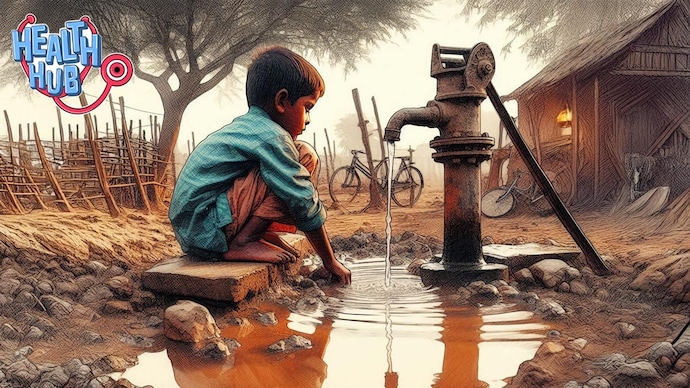Dirty water, poor diet: recipe for rising infections among Indian children
Millions of children in India are trapped in a cycle of malnutrition and infection due to contaminated water, poor sanitation and inadequate diet.

In India, millions of children face a silent but deadly threat every day: contaminated water and poor nutrition.
While health care advances have made progress in treating infectious diseases, the root causes – unsafe water, lack of sanitation and inadequate diet – continue to compromise children’s health.
The problem is not just access to food or medicine, but a cycle of malnutrition and frequent infections that leaves children vulnerable to poor health, stunted growth and diseases.
Dirty water, poor diet and infection
Studies have shown that there is a significant link between contaminated water, poor sanitation and childhood malnutrition. A study published in The Lancet Global Health reported that environmental enteropathy – an intestinal condition caused by prolonged exposure to unhygienic conditions – affects a large proportion of children in developing countries, including India.
This condition damages the lining of the intestine, impairs the absorption of essential nutrients and increases susceptibility to bacterial and parasitic infections.
Infectious disease specialist and epidemiologist Dr Judd Walson spoke to India Today about the deep connection between health systems and environmental factors that lead to the rise in infectious diseases and undernutrition in children.
“Poor sanitation and contaminated water create a perfect storm for infections in children,” he said.
Frequent infections, especially diarrhea and respiratory diseases, deplete a child’s nutritional reserves, leading to a cycle of malnutrition and further disease.
According to a 2021 UNICEF report, about 35% of Indian children under five are stunted, and 19% are wasted. These figures highlight not only the health crisis but also the long-term developmental challenge for the country.
Malnutrition and infection susceptibility
Malnutrition and infection are deeply interconnected, with one often influencing the other. Malnourished children have weak immune systems, making them more prone to infections like diarrhea, pneumonia and tuberculosis.
In rural India, limited access to clean drinking water and inadequate sanitation facilities further increase these risks.
Dr. Walson, who is currently the chair, said, “Malnutrition is not just about inadequate food intake. It is also about exposure to contaminated environments and the body’s inability to effectively absorb nutrients. These Addressing the root causes is the key to breaking this vicious cycle.” Department of International Health at the Johns Hopkins Bloomberg School of Public Health.
The World Health Organization (WHO) estimates that approximately 88% of diarrheal deaths globally are caused by unsafe water, inadequate sanitation and poor hygiene. In India, it remains one of the leading causes of child mortality, especially in underserved areas where access to health care is limited.
Dr. Walson said there is growing evidence that malnutrition is increasingly linked to an imbalance in gut bacteria, known as a disrupted microbiome. This imbalance can have lasting effects on growth, hormone regulation, and brain development.
“This disruption weakens the body’s ability to regulate essential processes and increases susceptibility to developmental issues,” he said.
Children who suffer from malnutrition in their early years have a higher risk of developing obesity and metabolic conditions such as diabetes later in life.
This occurs because the body adapts to limited resources during childhood, increasing the risk of overnutrition when food becomes more readily available.
Studies have shown that children who suffer from chronic malnutrition have a higher risk of developing metabolic diseases such as diabetes and cardiovascular problems later in life.
A 2023 study by the Indian Council of Medical Research (ICMR) found that stunted children are more likely to experience academic challenges and lower earning potential as adults. This perpetuates the cycle of poverty and poor health for generations.
Impact of poor groundwater quality on children’s health
A 2024 study published in Science of the Total Environment revealed wide variations in groundwater quality across India, with water unfit for consumption in about 26.5% of areas.
Factors such as high temperatures, low rainfall and dry soil conditions degrade water quality.
Poor groundwater quality is linked to malnutrition, increasing the likelihood of stunting, underweight and wasting among children by 35%, 38% and 11% respectively. Wasting is a type of malnutrition when a child is too thin for his or her height. This could be due to either losing weight too quickly or not gaining weight easily.
High levels of chemicals like magnesium, sulphates, nitrates, arsenic and total dissolved solids in water are major contributors to these issues.
practical solution
There is a need for clean water, proper sanitation and better nutrition programs like nutrition campaigns to improve the health of children in India. Early health care access is important to prevent complications. Educating families about sanitation, safe water and nutrition can create lasting change and reduce disease among children.
Dr. Walson highlights the importance of innovative solutions: “At Johns Hopkins, we are exploring targeted probiotic interventions to improve gut health and resilience against infection. These solutions, combined with traditional health care measures, “Offers hope to break the cycle of malnutrition and disease.”
He concluded: “India has the resources and knowledge to tackle this crisis. What is needed is sustained commitment, innovative solutions and a collaborative approach to truly bring about change.”
India must prioritize breaking the cycle of malnutrition and infection to secure a healthy future for its children.
